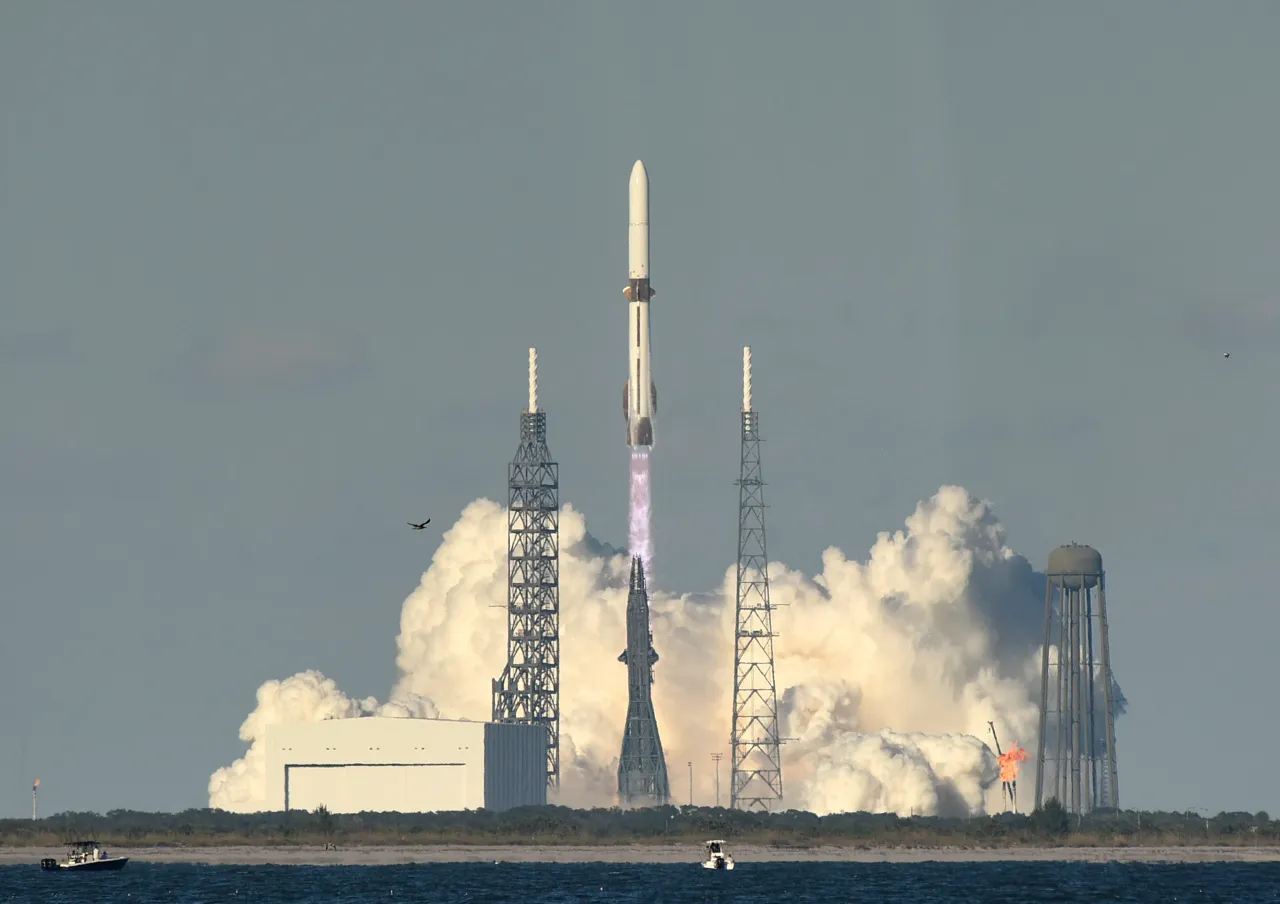Advertisement|Remove ads.
Blue Origin's New Glenn Sends NASA Satellites To Mars, Earns Plaudits From SpaceX Boss Elon Musk

- The launch date had been pushed back several times over the past few days due to bad weather.
- Besides delivering the two NASA satellites to their designated loiter orbit, the first-stage booster, named “Never Tell Me The Odds,” landed on a barge named Jacklyn.
- The New Glenn, named in honor of the first American to orbit the Earth, John Glenn, has been designed as a partially reusable rocket like SpaceX’s Falcon 9.
Blue Origin, the company owned by Jeff Bezos, successfully launched the New Glenn rocket on Thursday to send two NASA satellites toward Mars and landed the first-stage booster back on Earth for the first time.
New Glenn’s seven BE-4 engines ignited at around 3:55:01 PM ET from Launch Complex 36 at Cape Canaveral Space Force Station, emitting a cloud of smoke and flame as it set off for its second flight this year.
Delayed Launch Achieves Key Mission Objectives
The launch date had been pushed back several times over the past few days due to bad weather, specifically the Cumulus Cloud Rule, which prohibits launches when electric fields are present. The company also experienced an issue with its ground support equipment at the launch pad on Sunday.
Besides delivering the two NASA satellites to their designated loiter orbit, the first-stage booster, named “Never Tell Me The Odds,” landed on a barge named Jacklyn, a landing platform located several hundred miles downrange in the Atlantic. The name of the booster refers to a dialogue spoken by Harrison Ford’s character Han Solo in 1980’s “The Empire Strikes Back.”
The New Glenn, named in honor of the first American to orbit the Earth, John Glenn, has been designed as a partially reusable rocket like SpaceX’s Falcon 9, allowing multiple uses of the booster. On its first flight in January, New Glenn entered orbit, but Blue Origin failed to land the booster successfully.
“This is just the beginning as we rapidly scale our flight cadence and continue delivering for our customers,” said Blue Origin CEO Dave Limp in a statement.
Musk Lauds The Launch By SpaceX Competitor
SpaceX CEO Elon Musk, whose Falcon rockets are the most popular vehicles for commercial launches, also praised the launch. “Congratulations, Jeff Bezos, and Blue Origin team,” he wrote on X.
The likes of Blue Origin, Rocket Lab, and Firefly Aerospace are vying to take a bigger slice of the lucrative launch market from Elon Musk’s SpaceX, which is on track to launch its popular Falcon 9 rocket between 165 and 170 times this year. The 98m (321ft) rocket can carry a significantly higher payload than the Falcon 9 rocket to the Earth's lower orbit.
The launch was significant for the firm as it aims to play a key role in NASA’s efforts to send humans to the Moon and later to Mars. Rival SpaceX is also building its Starship rocket to take part in the missions.
“Every launch of New Glenn provides data that will be essential when we launch MK-1 through Artemis. All of this information will be critical to protect future NASA explorers and invaluable as we evaluate how to deliver on President Trump’s vision of planting the Stars and Stripes on Mars,” acting NASA administrator Sean Duffy said.
What Is The ESCAPADE Mission?
ESCAPADE, short for Escape and Plasma Acceleration and Dynamics Explorers, will use the two identical spacecraft named Blue and Gold to investigate how the solar wind interacts with Mars’ magnetic environment and how this interaction drives the planet’s atmospheric escape.
The mission was originally supposed to launch in October 2024, but was delayed as the New Glenn rocket was not flight-ready. The Blue and Gold satellites were built by California-based Rocket Lab, with instruments supplied by the University of California, Berkeley.
Retail sentiment on Stocktwits about Rocket Lab was in the ‘extremely bullish’ territory at the time of writing.
The two ESCAPADE spacecraft will begin their journey to Mars once the planets have returned to the ideal alignment in fall 2026. Satellite communications firm Viasat, also executed the first flight test of its launch telemetry data relay service onboard the New Glenn rocket.
Also See: Cannabis Stocks Drop As Shutdown Deal Tightens Hemp-THC Rules
For updates and corrections, email newsroom[at]stocktwits[dot]com.













/filters:format(webp)https://news.stocktwits-cdn.com/large_Netflix_jpg_ed6fa4554b.webp)
/filters:format(webp)https://st-everywhere-cms-prod.s3.us-east-1.amazonaws.com/unnamed_jpg_9dff551b50.webp)
/filters:format(webp)https://news.stocktwits-cdn.com/large_Magic_Mushroom_jpg_21662d693c.webp)
/filters:format(webp)https://st-everywhere-cms-prod.s3.us-east-1.amazonaws.com/shanthi_v2_compressed_98c13b83cf.png)
/filters:format(webp)https://news.stocktwits-cdn.com/large_pharma_stock_jpg_490939e580.webp)
/filters:format(webp)https://news.stocktwits-cdn.com/IMG_8805_JPG_6768aaedc3.webp)
/filters:format(webp)https://news.stocktwits-cdn.com/large_Getty_Images_2233231437_jpg_7f60abaf73.webp)
/filters:format(webp)https://news.stocktwits-cdn.com/vivekkrishnanphotography_58_jpg_0e45f66a62.webp)
/filters:format(webp)https://news.stocktwits-cdn.com/large_job_seekers_florida_resized_jpg_742e535d49.webp)
/filters:format(webp)https://st-everywhere-cms-prod.s3.us-east-1.amazonaws.com/Rounak_Author_Image_7607005b05.png)
/filters:format(webp)https://st-everywhere-cms-prod.s3.us-east-1.amazonaws.com/large_stock_rising_resized_f17852d7aa.jpg)